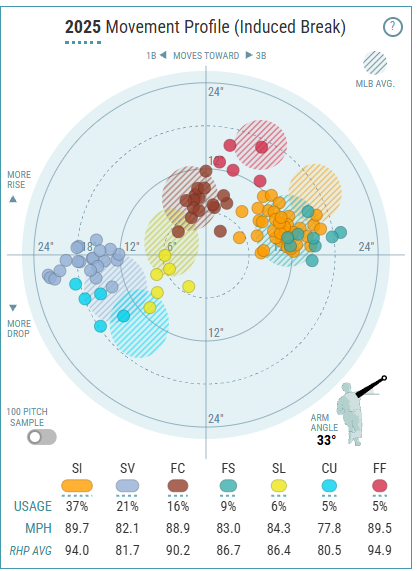Elliott looks at pitchers with surprising starts recently. These SPs could emerge as fantasy baseball waiver wire targets for Week 17 in 2025, or just mirages.
Welcome back to the "Are You For Real?" series as we dive into Week 16 of the 2025 fantasy baseball season. For those unfamiliar, this is a weekly column where we examine starting pitchers who had surprisingly strong starts over the past week and put them under the microscope to determine whether they're legitimate or just smoke and mirrors.
It's "Veterans Week" with "Are You For Real?". It's by happenstance, but we'll be analyzing three hurlers over the age of 30 who recently had strong starts. First, we'll look at Patrick Corbin's resurgence in Texas. Then, we'll deep dive into the return of Eric Lauer in Toronto. We'll round it out with a breakdown of Marcus Stroman's strong start for the Yanks.
Roster percentages are taken from Yahoo! and are accurate as of July 21.
Be sure to check all of our fantasy baseball lineup tools and resources:- Fantasy baseball trade analyzer
- BvP matchups data (Batter vs. Pitcher)
- PvB matchups data (Pitcher vs. Batter)
- Who should I start? Fantasy baseball comparisons
- Daily MLB starting lineups
- Fantasy baseball closer depth charts
- Fantasy Baseball live scoreboard
- Fantasy baseball injury reports
Patrick Corbin, Texas Rangers – 12% Rostered
2025 Stats (prior to this start): 93.1 IP, 4.15 ERA, 4.35 FIP, 12% K-BB%
07/18 vs. DET: 5.2 IP, 3 H, 0 ER, 2 BB, 6 K
Corbin came out of the All-Star break with a bang on Friday, blanking the MLB-best Tigers over five and two-thirds innings in a no-decision. Corbin has pitched much better since the calendar flipped to July, with a 2.16 ERA through three July starts. A former All-Star himself and a World Series champion, Corbin has certainly been around the block. Is the veteran southpaw experiencing a renaissance, or should he be ignored?
Originally a second-round pick by the Angels back in 2009, Corbin put together some incredible seasons in the late 2010s. Between 2018 and 2019, Corbin posted a 3.20 ERA, 10.8 K/9, and 2.98 FIP in 402 innings. Unfortunately, age caught up with him after the Nationals' magical 2019 World Series run, and Corbin fell apart.
Between 2020 and 2024, Corbin had a 5.62 ERA, 7.2 K/9, and 4.92 FIP in 137 games, making him among the worst starting pitchers in baseball to continue getting starts. His fat contract and the Nationals' lack of other options kept him in the rotation, but it was pretty obvious that Corbin was cooked.
The Rangers gave him a chance this season, and he’s held his own with a 3.91 ERA in 18 starts, doing his job as a veteran innings eater. Corbin works with a six-pitch mix consisting of a slider, sinker, cutter, changeup, four-seam fastball, and curveball. He throws the curveball less than 1% of the time and the four-seamer less than 4% of the time, so we’ll focus on his other offerings.
Corbin’s most used pitch is actually the slider, which he throws 35.1% of the time. Corbin has long been a slider-heavy pitcher, and he’s actually sort of a pioneer of this breaking ball-heavy approach. He was one of the first few pitchers in the 2010s to eschew traditional pitching wisdom, which says to lead with the fastball, and instead relied on his best pitch, the slider, to carry him. In its heyday, Corbin’s slider was among the best in baseball, but these days it’s lost a few steps.
An 80 mph offering, Corbin’s slider has average vertical movement and below-average horizontal movement, along with an average spin rate of 2224 RPM. Batters are hitting .246 against the pitch with a .402 SLG and a .287 wOBA. The expected stats suggest that Corbin has earned these results with a .252 xBA, .398 xSLG, and .288 wOBA. Corbin has an impressive 38% whiff rate with the pitch, and even when batters make contact, they aren’t hitting the ball with authority. Opponents have an 84.5 mph average exit velocity against Corbin’s slider along with a 16-degree average launch angle.
Corbin’s slider is nowhere near its previous version, but it could still be a solid pitch that Corbin can use to generate whiffs and get outs. It was working for him in this start as Corbin notched seven of his 10 whiffs with the pitch. It’s serviceable, and at age 36, what else can we ask for?
Corbin’s next most-used pitch is his sinker, which is his primary fastball. A 91.3 mph offering, Corbin hasn’t lost too much velocity from his peak of 92.3 mph. The sinker is a low spin offering at 2094 RPM, and has painfully average movement. The objective of most sinkers is to induce a ground-ball, but Corbin’s sinker hasn’t been effective in that regard this season. He has a 13-degree average launch angle and a 35.6% ground-ball rate with his sinker this year.
Batters have hit .271 off the sinker with a .424 SLG and a .334 wOBA, but the expected stats paint a different picture. Corbin has a .300 xBA, .497 xSLG, and .381 xwOBA with his sinker this season. Batters are crushing the pitch for a 91.9 mph average exit velocity. They’re literally sending it back harder than Corbin is firing it in. The pitch has performed better this season compared to his past few years, but overall, this is not a good pitch and one that batters should have no trouble handling.
Corbin also mixes in a cutter frequently, throwing his cutter 21.6% of the time this season. An 86.9 mph offering, Corbin’s cutter has below-average vertical and horizontal movement. He only began throwing the cutter last season, though it’s been his best pitch this year. Opponents are hitting .227 off Corbin’s cutter with a .440 SLG and a .327 wOBA. So, a good batting average against, but Corbin has given up his fair share of power with the pitch, too.
He’s also been a little lucky to post that .227 AVG against, as he has a .266 xBA and a .238 BABIP with the pitch. He is giving up soft contact with an 86.2 mph average exit velocity, but I’m not sure how much I can trust this pitch. It was hammered for a .301 AVG last year, and Corbin has just a 20% whiff rate with the pitch. It’s not a strikeout pitch, so his best bet is to induce weak contact, and that can be a dangerous game to play, especially for an aging southpaw.
Corbin also has a show-me changeup that he uses primarily against right-handed batters. This year, the pitch has been crushed for a .350 AVG, .450 SLG, and .347 wOBA, although Corbin has a .262 xBA, .327 xSLG, and .253 xwOBA with the pitch, which are actually his best expected stats of any offering.
He also has a monster 40.5% whiff rate with his changeup, albeit a small sample size as he’s only thrown the pitch 6.4% of the time. He’s been using the pitch a little more often lately, having thrown the changeup 11.4% of the time in July and 10% of the time against Detroit. I don’t think it’ll become a big part of Corbin’s game, but maybe he’d benefit from using the pitch more often. It could certainly help his strikeout numbers.
Verdict:
No, the Corbin of old is not back. The days of him as an All-Star are long gone, and he has very little fantasy appeal. His slider can still rack up the whiffs when it’s on, but it’s deteriorated over the years in terms of movement and is no longer elite. Corbin may be able to skate by, but that’s all he’s doing. His primary fastball is a sinker, which leaves much to be desired and no longer even induces groundballs at an above-average rate.
His cutter can induce weak contact, but lacks the ability to rack up whiffs. He’s begun throwing his changeup more often, which could serve him well as it’s performed decently this season, especially in terms of whiffs. All in all, Corbin is a middling veteran innings eater at this point. You could probably get away with streaming him against weak opponents and hope he gives you a quality start or picks up a win, but he has little strikeout upside at this point.
He could maybe have a sub-4 ERA if everything breaks right, but that’s his ceiling. His floor is a 5+ ERA and getting blown up every other game. His next start is scheduled for Wednesday, the 23rd, against the Athletics, and you could start him there as the Athletics have a 94 wRC+ and a 24.6% K rate against left-handed pitchers this season, though I wouldn’t be very excited about it.
Eric Lauer, Toronto Blue Jays – 32% Rostered
2025 Stats (prior to this start): 55 IP, 2.78 ERA, 3.38 FIP, 19.1% K-BB%
07/19 vs. SF: 6 IP, 2 H, 2 ER, 0 BB, 7 K
The good times continued for Lauer on Saturday, who notched his second quality start in his last three games and earned his fifth win of the season. Lauer has been an unexpected cog in Toronto’s rotation this season, having transitioned from reliever to starter. He’s flamed out as a starter in the past, but he’s got a 3.61 ERA as a starter this season. Is Lauer someone we can trust, or should we steer clear?
Originally a first-round pick by San Diego back in 2016, Lauer had some prospect pedigree attached to his name coming up, with hopes of him developing into a mid-rotation piece. Lauer found some success after being traded to Milwaukee, including posting a 3.47 ERA in 277.1 innings between 2021-2022. Injuries and poor performances had Lauer on the outs, and he even spent 2024 in the KBO in Korea. Lauer works with a five-pitch mix consisting of a four-seam fastball, cutter, curveball, slider, and changeup.
Lauer’s most-used pitch has been the four-seam fastball, which he throws 46.1% of the time. It has worked wonders for him this season. A 91.8 mph offering, Lauer’s fastball doesn’t seem like much on paper. It has an average spin rate of 2238 RPM and features a rather typical shape, with relatively average vertical and horizontal movement. However, batters are hitting just .183 off the pitch, with a .344 SLG and a .256 wOBA.
The expected stats suggest that Lauer has also earned these results, with a .189 xBA, .352 xSLG, and .261 xwOBA. How does Lauer do it? Elevation. He keeps the ball up in the zone and above the zone, and induces plenty of fly-balls. He has a 26-degree average launch angle off his four-seamer this season, and has a 53.2% fly-ball rate with the pitch. Fly-balls are the least likely batted ball type to fall for a hit, so it can be beneficial to have such extreme fly-ball tendencies.
While this fly-ball heavy approach has its merits, I’m skeptical that Lauer can sustain this performance, even with the favorable expected stats. He has been surviving thanks to a .233 BABIP with his four-seamer this season, compared to a career .305 BABIP. His low BABIP is especially curious given the 29% line drive rate and 91.5 mph average exit velocity off his four-seamer this season. One might also expect Lauer to experience home run regression, since he has a career 1.41 HR/9 but a 1.03 HR/9 this season. His 8.6% HR/FB rate will likely regress towards his career mark of 13.1%, upping his home run rate.
After the fastball, Lauer’s next most-used pitch is his cutter, which he throws 21.4% of the time. An 86.5 mph offering, the cutter sort of lands in between his four-seamer and slider. It has more movement and spin than the fastball, but not quite as much as his slider or other secondary offerings. Batters have struggled against this pitch, hitting just .208 with a .396 SLG and .298 wOBA. The expected stats paint a different picture, however, with a .270 xBA, .468 xSLG, and .351 xwOBA against the pitch.
Like with his fastball, Lauer has a much lower BABIP this season (.250) compared to his career mark (.312), and one should expect regression. Lauer also induces his fair share of fly-balls with the cutter as he has a 21-degree average launch angle against with the pitch. It’s not as extreme as his fastball, but it still can be a good trait to have, although it may be harder to pull off this fly-ball heavy approach in the AL East in Toronto for Lauer. He’s spent the majority of his career in Milwaukee, where the ball can fly out with ease, and he’s struggled with homers his entire career.
Lauer’s next most-used pitch is the curveball, which he throws 13.9% of the time. A 75.4 mph offering. Lauer’s curveball is noteworthy for its low spin and below-average movement, but it still has that traditional loopy curve. He didn’t use it that often against San Francisco, only throwing seven curveballs total. Opponents have struggled against this pitch this season, hitting just .214 with a .357 SLG and .301 wOBA. The expected stats are even better, with a .180 xBA, .296 xSLG, and .263 xwOBA.
The curveball is the rare pitch for Lauer that doesn’t have fly-ball tendencies, with a 5-degree average launch angle against. Only the curveball and his changeup with a 4-degree average launch angle are not fly-ball pitches. Lauer also has a decent 26.9% whiff rate with the pitch, but he did not secure a whiff in this start with the curveball. The curveball is a pitch that Lauer can wield effectively against right-handed hitters, and he seems to mix in both his curveball and changeup against left-handed hitters.
One pitch that Lauer has begun throwing more often is his slider. He only has a 9.6% slider usage rate on the year, but he’s had double-digit slider usage in each of his last four starts. An 82.7 mph offering, the slider can be loopy like a harder version of his curveball, though the curveball has much more drop. Batters have really struggled against Lauer’s slider this season, with a .167 AVG, .250 SLG, and .174 wOBA against.
The expected stats are somehow better, with a .143 xBA, .209 xSLG, and .148 xwOBA against. Lauer has extreme fly-ball tendencies with this pitch as well, with a 27-degree average launch angle against and a 52% fly-ball rate. The slider is also Lauer’s best strikeout pitch, with a 30.2% whiff rate on the year. 30% isn’t anything special for a slider, but it is Lauer’s best strikeout pitch.
It would be great to see Lauer continue to increase his slider usage, as it seems to be one of his most effective offerings. Overall, Lauer is showcasing some improvements on the mound to the point where I could believe that he can hack it as an MLB starter, but he is undoubtedly getting lucky too.
There are three stats I like to look at for a quick gauge of how lucky a pitcher is getting (BABIP, LOB rate, HR/FB rate), and Lauer is overperforming in all three metrics. He has a .240 BABIP, 82% LOB rate, and 8.6% HR/FB rate. We should expect all three to normalize to either the league average or Lauer’s career averages, but either way, he will likely regress. Pay attention to his 3.82 xFIP. Lauer has always had home run issues, and xFIP normalizes for home run rate, so it could be a good estimate of where Lauer’s ERA could end up if and when the other shoe drops.
Verdict:
Lauer has resurrected his career from the brink, and that is commendable in itself. That being said, Lauer is definitely overperforming and should experience regression going forward. He could be usable as a streamer in a pinch or against weak lineups, but he’s not someone I’d be willing to trust every time out. His stuff, led by a 91.8 mph heater, is rather underwhelming, and I’m unsure if he can sustain his current 27.1% K rate. He has a career 22.4% strikeout rate, and he’d never been above 24% prior to this season.
His fly-ball tendencies can lead to easy outs for his fielders, but he’s walking a tightrope pitching this way in the AL East in Toronto. His BABIP, LOB rate, and HR/FB rate all deviate from the league average and should regress going forward. His next start is scheduled for Thursday at Detroit, and I’d avoid him there. Detroit has a .332 wOBA and 114 wRC+ against left-handed pitchers this season, making them one of the most potent lineups against southpaws in the league. Lauer also has a 1.36 HR/9 and a 4.15 FIP on the road this season.
Marcus Stroman, New York Yankees – 6% Rostered
2025 Stats (prior to this start): 24.1 IP, 6.66 ERA, 5.60 FIP, 2.7% K-BB%
07/20 @ ATL: 6 IP, 5 H, 1 ER, 0 BB, 4 K
Stroman was fantastic on Sunday, holding the Braves to just one run over six innings for his first quality start and second victory of the season. Stroman has been pitching better since returning from the injured list, having posted a 3.00 ERA through four starts since coming back. Another former All-Star and fantasy mainstay, Stroman has certainly lost a few steps over the years, but is there any value to be had in the 34-year-old righty?
Originally a first-round pick by Toronto back in 2012, Stroman was a big-deal prospect thanks to his excellent control and ground-ball tendencies. At his peak, he was a mid- to low-3s ERA pitcher with good walk rates and a good WHIP, but lacked big strikeout upside. Stroman works with a seven-pitch mix consisting of a sinker, slurve, cutter, splitter, slider, curveball, and four-seam fastball.
That’s one big repertoire, and Stroman manages to use them all to a degree, throwing each pitch at least 4.6% of the time this season. His most used pitch is probably his most famous pitch, and that would be the sinker. An 89.7 mph offering, Stroman’s sinker has lost a few ticks compared to its peak of 93.3 mph.
Stroman was at least able to keep it above 91 mph as recently as 2023, but his velocity took a dive when he joined the Yankees and hasn’t recovered. He has above-average vertical movement and below-average horizontal movement with his sinker, giving it an odd and atypical shape. Here’s a look at Stroman’s movement profile (sinker in orange).
This type of movement profile can make the pitch deceptive and difficult for opposing hitters to square up, often resulting in groundballs. That’s how Stroman got it done during his peak, although his sinker isn’t as effective these days. He has a 9-degree average launch angle against the sinker, whereas it was usually hovering around zero or even negative during his peak. His 56% ground-ball rate with the pitch is fine, but a far cry from his career 63.8% mark.
Overall, batters have had no problem handling Stroman’s sinker. Opponents have a .281 AVG, .456 SLG, and .352 wOBA off Stroman’s sinker this season. The expected stats are even worse with a .295 xBA, .522 xSLG, and .379 xwOBA. In addition to the diminishing ground-ball rate, it must be noted that batters are practically atomizing the ball when making contact. He’s allowing a 93.2 mph average exit velocity against his sinker and a 54% hard hit rate. Sure, Stroman can still get a groundball or two, but the sinker itself is no longer effective.
His next most used pitch has been his best this season, and that’s his slurve. An 82.1 mph offering, Stroman’s slurve has plus horizontal movement and dies down and away from right-handed hitters. Batters have really struggled against this pitch this season, hitting just .176 with a .176 SLG and .186 wOBA. The expected stats suggest that regression is coming, but that it won’t be so bad with a .238 xBA, .312 xSLG, and .263 xwOBA.
Stroman has done a great job limiting hard contact with the pitch, with an 84.2 mph average exit velocity against. He’s also done a better job inducing groundballs with this pitch, given his five-degree average launch angle against. The slurve isn’t a strikeout pitch as Stroman has just a 23.1% whiff rate with it, but it could be an effective offering for its ability to induce weak contact and groundballs.
Stroman also uses his cutter quite frequently, having thrown it 23% of the time in this start and 15.9% of the time on the season. Although looking at the results against this pitch, it’s a mystery as to why Stroman would throw it so often. Batters have clobbered Stroman’s cutter for a .381 AVG, .952 SLG, and .580 wOBA. Oh, and he has a .379 xBA, .822 xSLG, and .534 xwOBA with the pitch as well. Yikes.
Stroman also has a pitiful 6.4% whiff rate with the pitch, and batters are hitting the sweet spot with a 19-degree average launch angle against it. The cutter has been routinely knocked around by opponents for the past few seasons, so it’s curious that Stroman is still throwing it so often. There seem to be no redeeming qualities to this pitch; it just gets hit hard.
Stroman throws the rest of his pitches under 10% of the time, but one that’s stood out this season is the splitter. An 83 mph offering, Stroman’s splitter is more of a split-change with its low velocity and reduced spin rate. Opponents have really struggled against the pitch this season, hitting just .071 with a .071 SLG and a .063 wOBA.
Stroman also has a 33.3% whiff rate with the pitch, making it one of his best strikeout pitches. Stroman has ramped up his splitter usage over his last three appearances, using it more than 11% of the time in each of his last three starts. I don’t think this pitch will transform Stroman into some strikeout pitcher at this stage of his career, but it’s a positive trend to see nonetheless.
Strikeouts have long been a concern for Stroman, who has just a 19.6% career strikeout rate. He’s always gotten it done by pitching to contact and inducing groundballs, but his strikeout rate has plummeted these past few seasons. He has just a 14.2% K rate on the year, which is among the lowest in all of baseball.
It would be easier to forgive if Stroman could help in other categories, but his 3.56 BB/9 means he isn’t helping in WHIP, and he’s giving up 1.48 HR/9. Sure, he could experience some positive regression, but he currently has a .289 BABIP and a 5.27 FIP. The surface stats and the advanced stats both think he stinks, and I’d have to agree.
Verdict:
The All-Star days seem far behind Stroman, and he was an All-Star just two years ago. His velocity has cratered to 89.7 mph, making him one of the softest-tossing right-handers in the league. He no longer induces ground-balls at the prodigious rate he once did, and Stroman’s sinker is getting crushed for a 93.2 mph average exit velocity.
His secondary stuff is hit or miss—mostly miss. His best pitch these days is probably the slurve or splitter, but both can merely complement an already effective repertoire, not prop up an aging hurler on their own. You won’t get strikeouts, he may be a WHIP and ERA liability, and he doesn’t even pitch that deep into games normally. I suppose you could stream him in a pinch, but for what upside? His biggest strength is that he pitches for a good team and might earn a few wins while he’s part of the rotation.
More Fantasy Baseball Advice
Download Our Free News & Alerts Mobile App
Like what you see? Download our updated fantasy baseball app for iPhone and Android with 24x7 player news, injury alerts, sleepers, prospects & more. All free!






 RADIO
RADIO

























